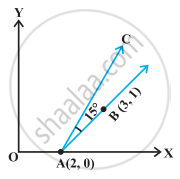Advertisements
Advertisements
प्रश्न
If the line joining two points A(2, 0) and B(3, 1) is rotated about A in anticlock wise direction through an angle of 15°. Find the equation of the line in new position.
उत्तर
The slope of the line AB is `(1 - 0)/(3 - 2)` = 1 or tan 45° (Why?)
After rotation of the line through 15°
The slope of the line AC in new position is tan 60° = `sqrt(3)`
Therefore, the equation of the new line AC is
y – 0 = `sqrt(3) (x - 2)`
or `y - sqrt(3)x + 2sqrt(3)` = 0
APPEARS IN
संबंधित प्रश्न
The base of an equilateral triangle with side 2a lies along they y-axis such that the mid point of the base is at the origin. Find vertices of the triangle.
Without using the Pythagoras theorem, show that the points (4, 4), (3, 5) and (–1, –1) are the vertices of a right angled triangle.
A line passes through (x1, y1) and (h, k). If slope of the line is m, show that k – y1 = m (h – x1).
Consider the given population and year graph. Find the slope of the line AB and using it, find what will be the population in the year 2010?

Find the value of p so that the three lines 3x + y – 2 = 0, px + 2y – 3 = 0 and 2x – y – 3 = 0 may intersect at one point.
Find the equation of the lines through the point (3, 2) which make an angle of 45° with the line x –2y = 3.
Find the slope of the lines which make the following angle with the positive direction of x-axis:
\[- \frac{\pi}{4}\]
Using the method of slope, show that the following points are collinear A (16, − 18), B (3, −6), C (−10, 6) .
Show that the line joining (2, −5) and (−2, 5) is perpendicular to the line joining (6, 3) and (1, 1).
Line through the points (−2, 6) and (4, 8) is perpendicular to the line through the points (8, 12) and (x, 24). Find the value of x.
Find the equations of the bisectors of the angles between the coordinate axes.
Find the equation of a line which is perpendicular to the line joining (4, 2) and (3, 5) and cuts off an intercept of length 3 on y-axis.
Show that the perpendicular bisectors of the sides of a triangle are concurrent.
If the image of the point (2, 1) with respect to a line mirror is (5, 2), find the equation of the mirror.
The line through (h, 3) and (4, 1) intersects the line 7x − 9y − 19 = 0 at right angle. Find the value of h.
The angle between the lines 2x − y + 3 = 0 and x + 2y + 3 = 0 is
The coordinates of the foot of the perpendicular from the point (2, 3) on the line x + y − 11 = 0 are
If m1 and m2 are slopes of lines represented by 6x2 - 5xy + y2 = 0, then (m1)3 + (m2)3 = ?
Find the equation to the straight line passing through the point of intersection of the lines 5x – 6y – 1 = 0 and 3x + 2y + 5 = 0 and perpendicular to the line 3x – 5y + 11 = 0.
The two lines ax + by = c and a′x + b′y = c′ are perpendicular if ______.
The intercept cut off by a line from y-axis is twice than that from x-axis, and the line passes through the point (1, 2). The equation of the line is ______.
The reflection of the point (4, – 13) about the line 5x + y + 6 = 0 is ______.
If the equation of the base of an equilateral triangle is x + y = 2 and the vertex is (2, – 1), then find the length of the side of the triangle.
A variable line passes through a fixed point P. The algebraic sum of the perpendiculars drawn from the points (2, 0), (0, 2) and (1, 1) on the line is zero. Find the coordinates of the point P.
P1, P2 are points on either of the two lines `- sqrt(3) |x|` = 2 at a distance of 5 units from their point of intersection. Find the coordinates of the foot of perpendiculars drawn from P1, P2 on the bisector of the angle between the given lines.
One vertex of the equilateral triangle with centroid at the origin and one side as x + y – 2 = 0 is ______.
The line which passes through the origin and intersect the two lines `(x - 1)/2 = (y + 3)/4 = (z - 5)/3, (x - 4)/2 = (y + 3)/3 = (z - 14)/4`, is ______.
